Chopstick-lickin’ good: Where to find Asian takes on fried chicken in Orange County

- Share via
Is there a dish more universal than fried chicken? Whether it’s battered, cooked naked, served whole or in pieces, fried chicken is enjoyed throughout the world.
Asian countries are particularly fond of fried chicken. In South Korea, where about 50,000 fried chicken restaurants make it a ubiquitous fast-food staple, nearly a third of the chicken consumed was fried. But everywhere in Asia, from Indonesia to Japan, you’ll find variations of the dish that’s not only finger-lickin’ good but provides a peek into each country’s distinct culinary style.
So this month, when roast turkey is inevitable, here are six Orange County restaurants where you can sink your teeth into unique Asian takes on fried chicken. It is, in this writer’s opinion, the best gateway dish to further explore a cuisine — because, let’s face it, you can’t eat fried chicken without side dishes.
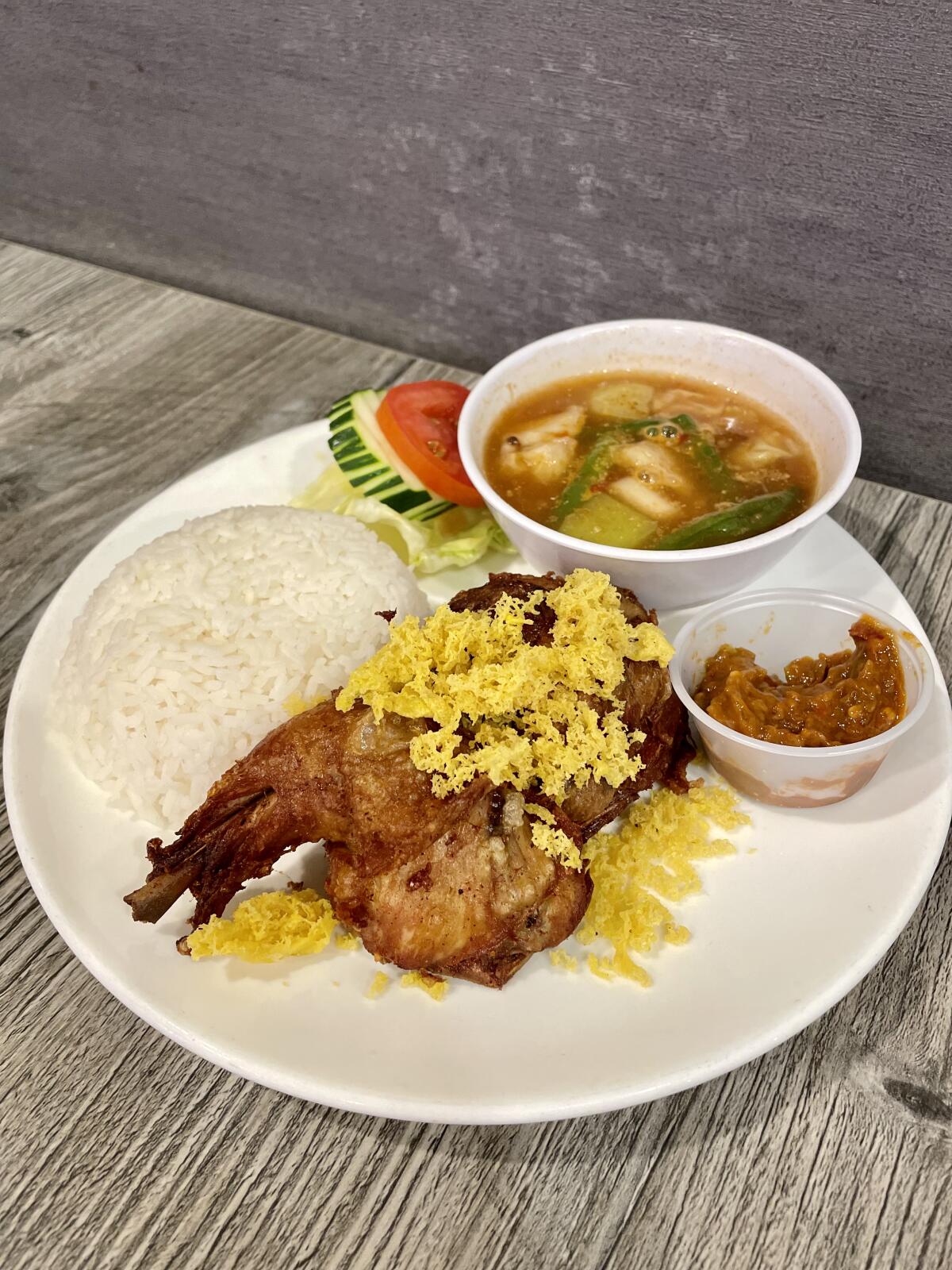
INDONESIA
Rice & Noodle, 608 E. 1st St., Tustin
When you order the ayam kremes at Rice & Noodle in Tustin, you get a dark brown, whole, deep fried Cornish hen showered with the golden crumbles of its disembodied crust. The latter is the “kremes,” which roughly translates to “crispy things.” Think of this addictive substance also as a seasoning — because it is. Made of rice flour and spices, the batter sings notes similar to the bird, but concentrated in every speck of its tempura-like crumb are flavor bursts you want to chase with rice.
This isn’t the only recipe for fried chicken that exists in Indonesia, but it’s one of the most popular. Ayam kremes begat KFC-like empires, the least of which is called Ayam Goreng Suharti, arguably the closest thing Indonesia has to a homegrown Col. Sanders.
Dollop each morsel you tear off from the well-fried carcass (note: Indonesians prefer their chickens fried to the point of dryness) with the house-made sambal — a savory and intensely hot chili paste inflected by the stinky, umami-rich accents of terasi, Indonesia’s indigenous fermented shrimp paste.
Since no Indonesian eats ayam kremes all by itself, you shouldn’t either. So be sure to order the nasi ayam kremes, which pairs a half portion of chicken with rice, fresh-cut cucumbers, some tomato and a bowl of sayur asem, a refreshing vegetable soup made tangy with tamarind. These sides are essential pairings to Indonesian fried chicken as coleslaw and mashed potatoes are at KFC.

JAPAN
Furaibo, 3396 S. Bristol St., Santa Ana
Nagoya, a Japanese port city, is home to the headquarters of Lexus. But in Japan, the town is more famous for being the birthplace of tebasaki — crispy chicken wings brushed with special sauce. Like Buffalo, Nagoya is forever linked to its wings, which were invented in a restaurant called Furaibo over 50 years ago.
The story of how they were conceived echoes the myth of how Buffalo wings were born. Rather than using the wings to make stock, Furaibo’s owner decided to deep fry them and coat them with an addictive soy sauce glaze redolent of garlic. The rest is fried chicken history.
Furaibo now boasts branches in Los Angeles and Gardena. The newest branch opened last year in Santa Ana, and though it is billed as an izakaya (a Japanese pub) like its predecessors, you come for those famous sauce-shellacked wings, or if you’re hungry, an entire chicken.
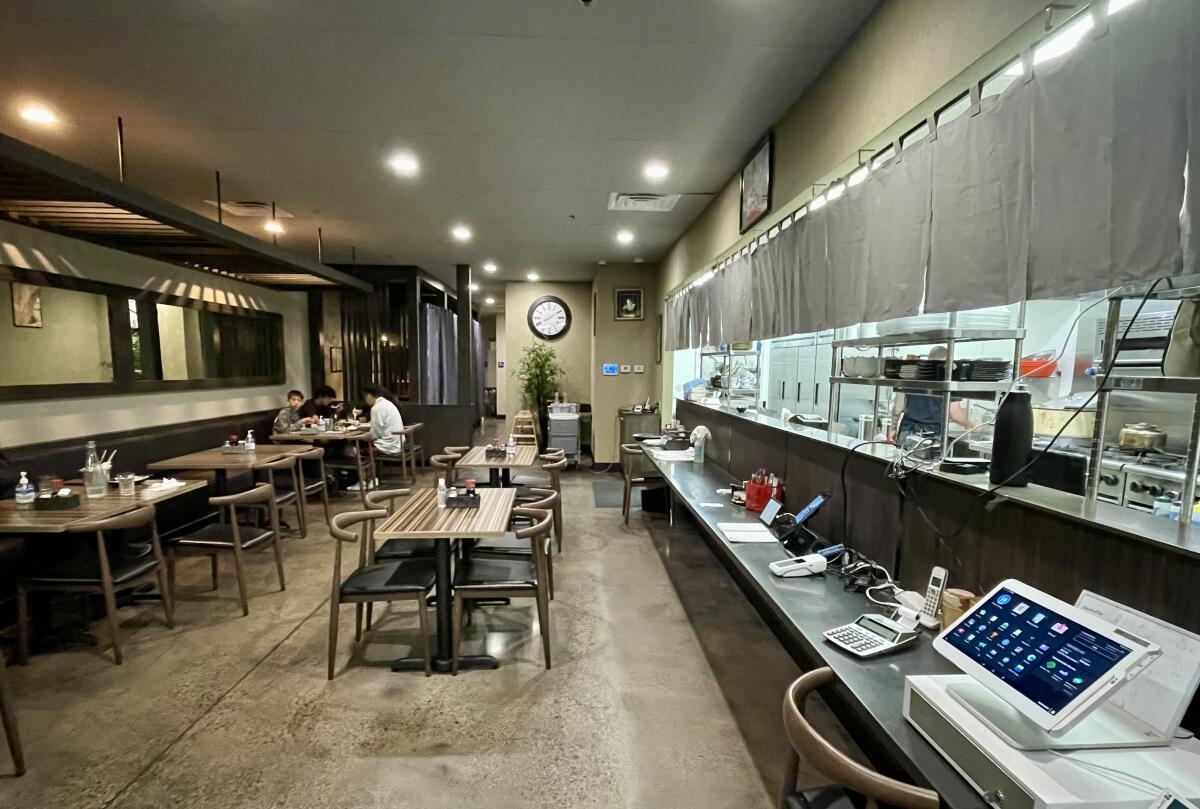
Opt for the wings and you’ll notice all are flats — the perfect bar food. If you order the “Chita,” you get a leg and thigh that are enough for a light snack. The “Jane” is a piece of breast, and the “Tarzan” entitles you to half a bird that has the tips of the drumstick and wing wrapped in foil so that you don’t get your fingers dirty.
Every piece of chicken at Furaibo gets the same treatment — fried with just a light coating of starch, then glazed with the pub’s signature reduction of soy, grated ginger, grated garlic, sake, mirin, sugar and vinegar. As sides to your chicken haul, you should order a few izakaya dishes to balance all the deep-fried meat; but just like if you were devouring Buffalo wings at an American bar, a pitcher of beer is not inappropriate.
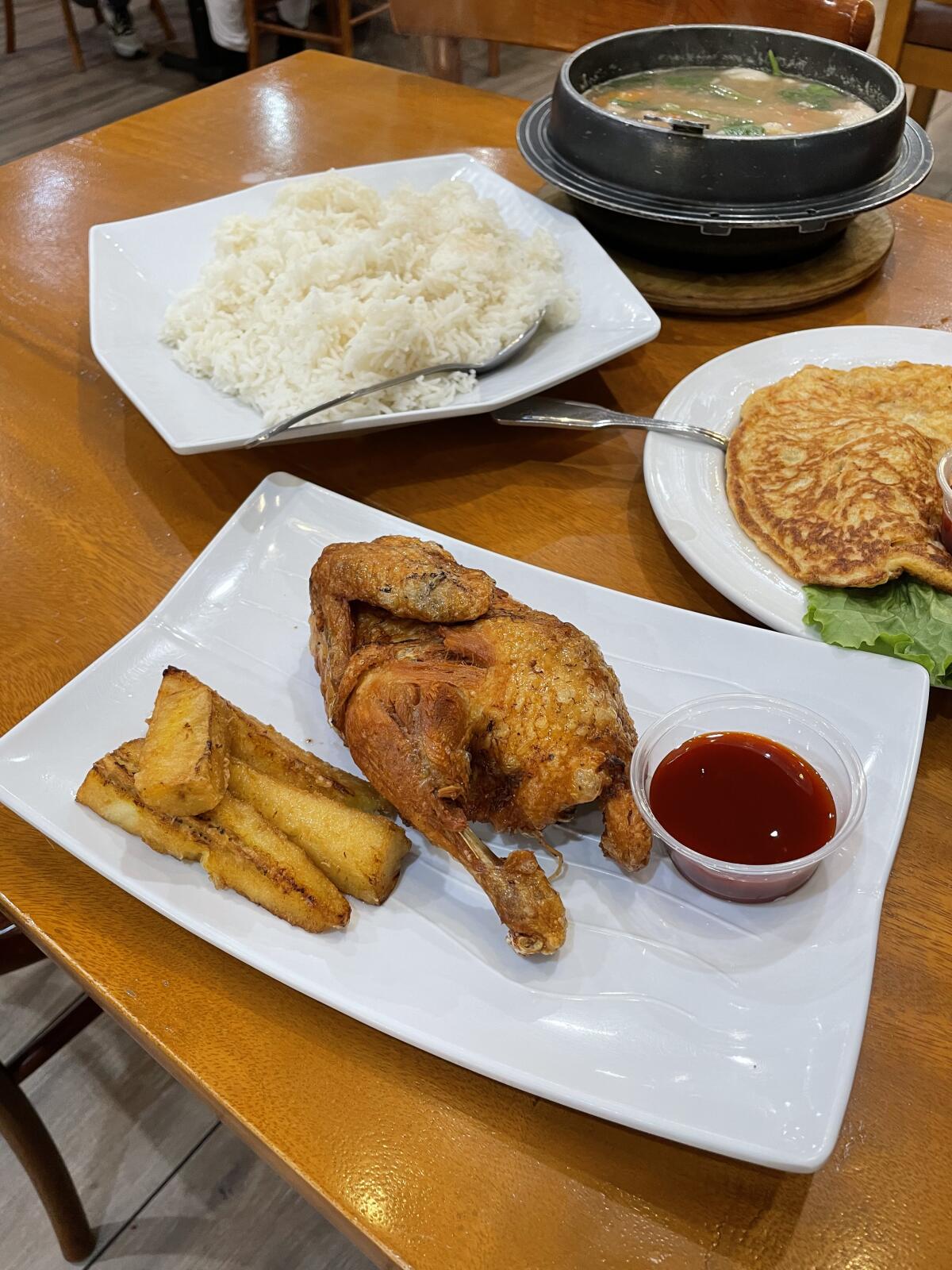
PHILIPPINES
Barrio Fiesta, 1199 N. Euclid St., Anaheim
You might have expected Jollibee to appear in this spot. As good as Jollibee’s chicken is, I would argue that the brand, founded in 1978 in the Philippines as a direct response to the introduction of McDonald’s and KFC, doesn’t sell Filipino fried chicken. It actually offers an American-style fried chicken that’s slightly adapted to suit Filipino palates.
Though most Jollibee branches do offer a smattering of Filipino dishes such as a rice noodle dish called palabok to accompany its chicken, mashed potatoes and gravy is still a popular option. I would argue that the new Barrio Fiesta in Anaheim — the first Orange County branch of a Philippines-based restaurant chain — is a better venue if you want the fried chicken to be a gateway to discovering more of the cuisine.
Unlike Jollibee’s chicken, Barrio Fiesta’s birds do not have any batter or breading. They are fried naked to turn the skin shatteringly crisp in the hot oil. This is the same oil, by the way, that Barrio Fiesta cooks its signature dish, crispy pata, a deep-fried pork leg that no doubt melts a good amount of pork fat into the medium — an unintentional but not unwelcome contributor of flavor to the chicken.
Eat the chicken with some of the banana ketchup they give you in a saucer. It tastes like regular ketchup but with the fruitiness and sweetness amped up by 10. An actual fried banana served on the side also answers the salty chicken with its own sweetness and tang.
But if you order the fried chicken at Barrio Fiesta, the expectation is that it will be just one of the many dishes you’re having for dinner. For sure, you should include a side of rice and a vegetable dish. Or maybe the sinigang, a hot cauldron of tamarind-soured soup that almost expects to be paired with something fried.
Know that for every dish you order, you must have at least three people in attendance who are prepared to eat it with you. The immense portion sizes at Barrio Fiesta are designed for sharing with extended family or friends who will fight for the last drumstick.
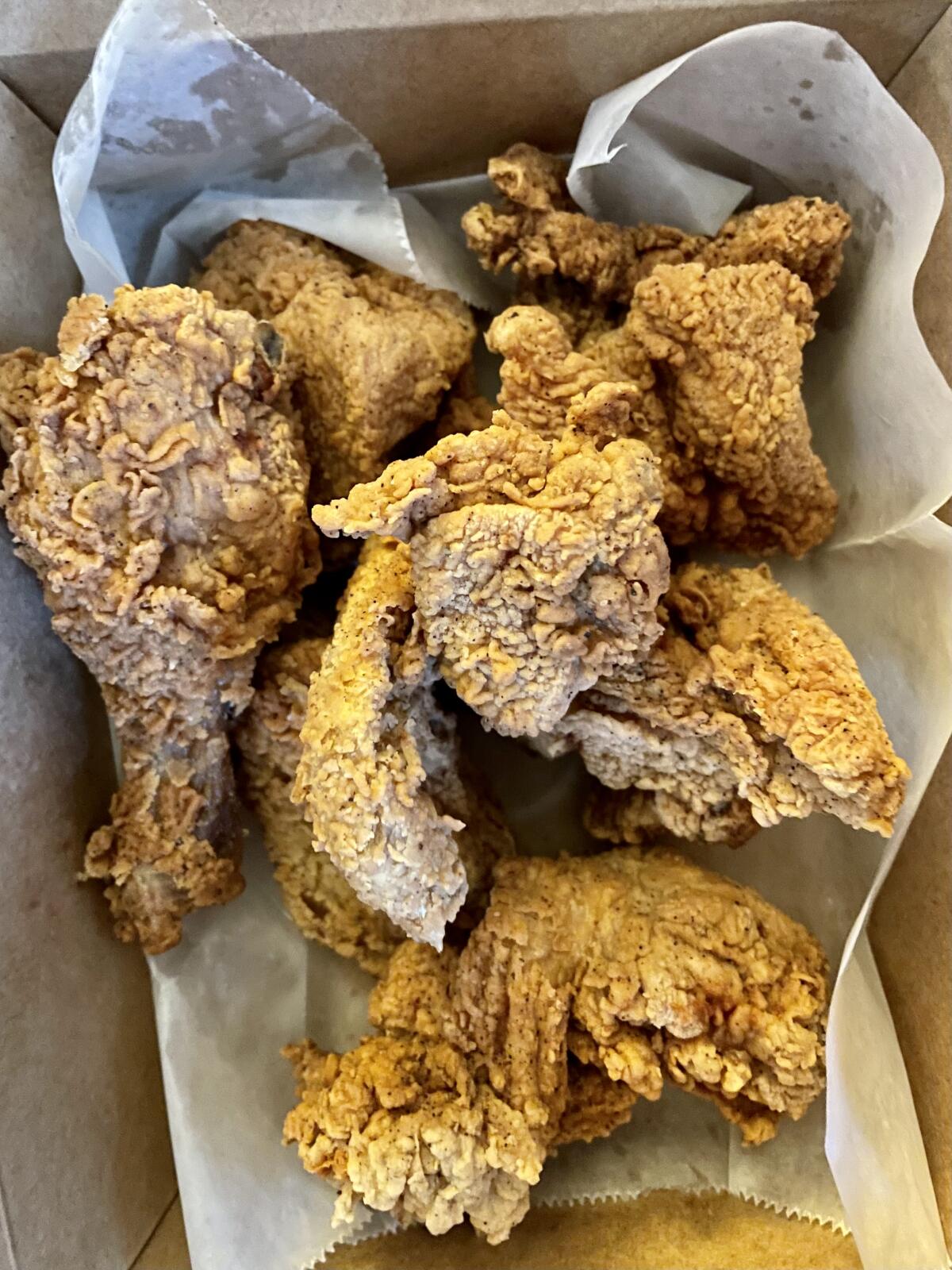
SOUTH KOREA
Love Letter Pizza & Chicken, 2600 Alton Pkwy., Irvine
Korean fried chicken is everything American-style fried chicken is — decadent, crispy, really bad for you.
But with a wealth of Korean fried chicken chains such as Kyochon and Pelicana dotting the O.C. landscape, picking a favorite is as personal as declaring your favorite BTS member. And this is before factoring choices of sauce and batter styles.
Enter Love Letter Pizza & Chicken, which offers its fried chicken in a humble pick-up stall hidden in one corner of the original H-Mart in Irvine.
Don’t let the food-court surroundings deceive you. As you wait for the chickens to cook, you’ll see your fried chicken craftsman poking the pieces in his fryer with a skewer, checking them for doneness. Love Letter’s basic “crispy fried chicken” exemplifies the Korean way of frying poultry — a double-fry method that melts all the subcutaneous fat and renders the skin to the thinness of parchment. Beneath the crust, the meat is typically unseasoned. Except for a light touch of soy in the batter, the meat tastes of pure poultry-ness.
A whole order of chicken comes with 14 small-sized pieces. But because Love Letter does not serve beer, pick up a case of Hite at the supermarket while you await the chicken. Then rush straight home to eat the piping hot pieces. Cool off with the refreshing vinegar-steeped cubes of pickled radish and chase with copious amounts of lager.
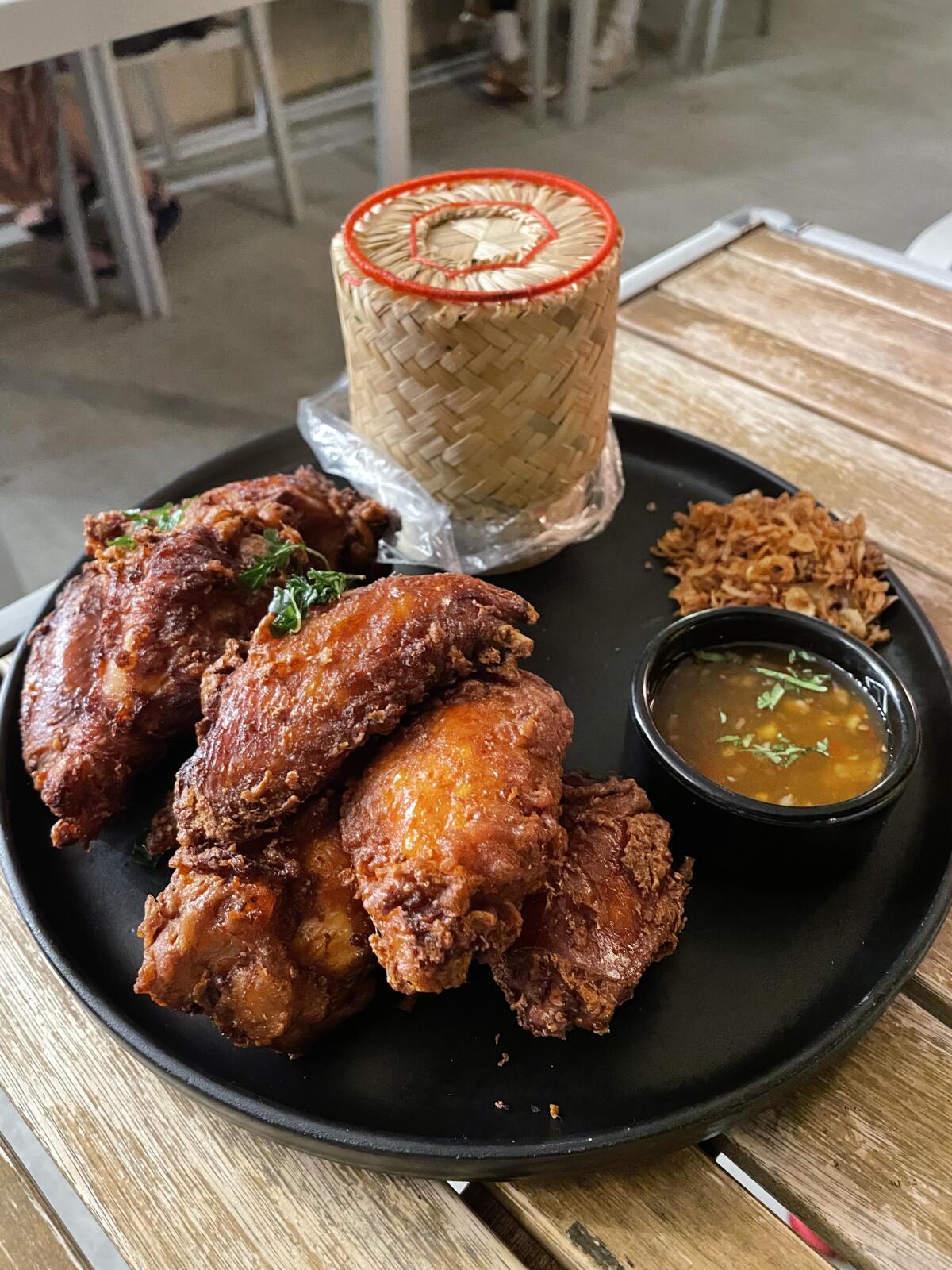
THAILAND
Hanuman Thai Eatery, 355 Bristol St. Ste. U, Costa Mesa
Hanuman Thai Eatery, 1835 Newport Blvd. Ste. D-154/155, Costa Mesa
If you strolled through the center of Hat Yai, a city in southern Thailand, you’d notice the persistent aroma of fried chicken wafting in the air. This municipality, more than any other in the country, is renowned for a dish called gai tod Hat Yai, a style of fried chicken that originated here at street-side stalls but became so beloved that it has now proliferated throughout Thailand.
The recipe for Hat Yai-style fried chicken is simple. The pieces are soaked overnight in a brine fortified with fish sauce, soy sauce, sugar, white pepper, mashed garlic and cilantro roots. Then, right before frying, rice flour is added to turn the brine into a thin batter. After it’s fried golden, the flavor of the marinade permeates all the layers — the crispy crust, the rendered skin, and the juicy meat. It’s then served with sticky rice, which is optional, and showered with crispy shallots, which is not optional. In L.A., you’ll find faithful renditions of gai tod Hat Yai at a handful of Thai joints, but none so revered as the version served at Anajak, the L.A. Times’ 2022 Restaurant of the Year.
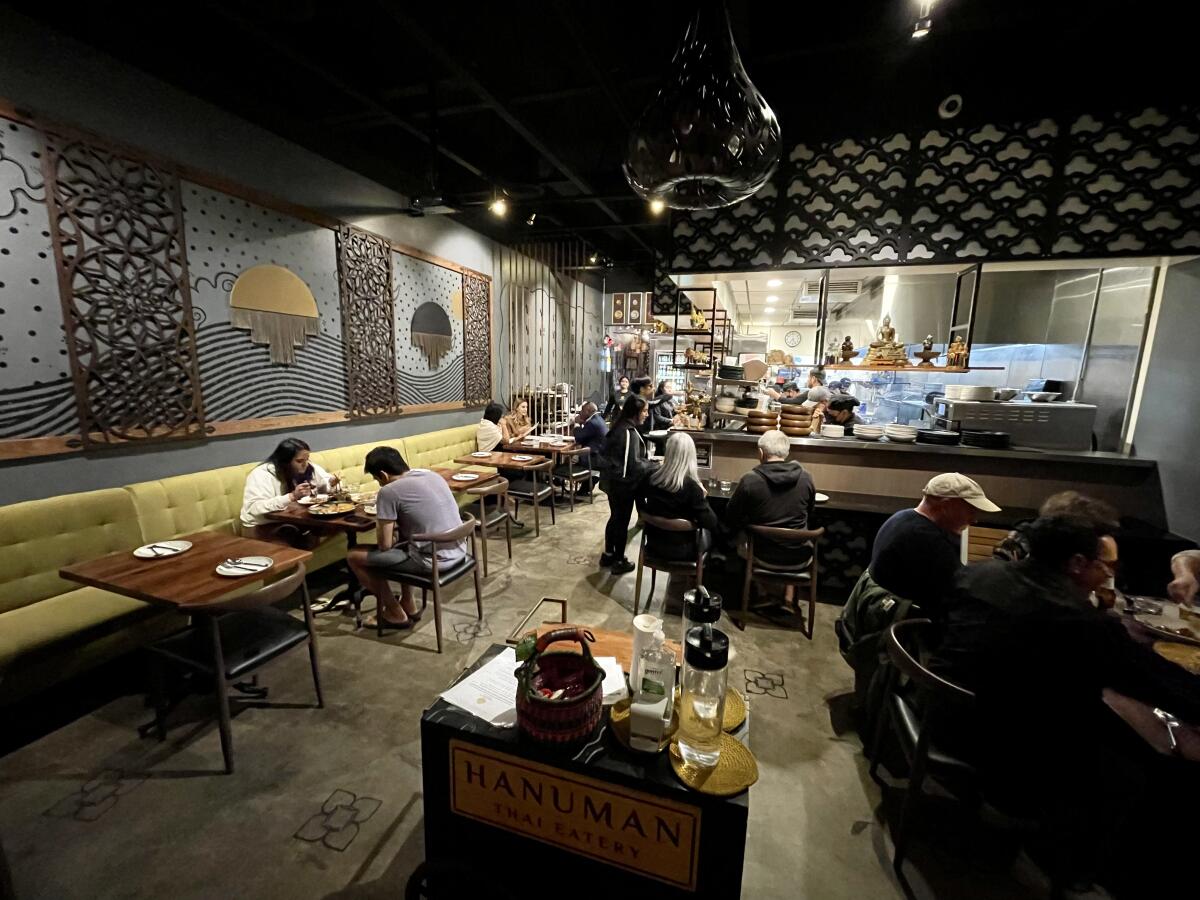
While the style is still rare in Orange County, both the original and newest location of Hanuman Thai Eatery, whose chef is from Hat Yai, feature it as a house specialty. The flavor of the chicken is milder here than at Anajak. And rather than a breast, a wing, a thigh and a drumstick, the chicken comes out only as a stack of wing pieces — which is perhaps better for equitable table sharing.
But because you would’ve waited at least an hour to get a table at this unusually popular restaurant, you shouldn’t stop at the fried chicken. Get the green papaya salad, which is a common accompaniment to gai tod Hat Yai. Since it’s light and practically a health food, the salad counts as both a palate cleanser and a hall pass to eat more fried chicken.
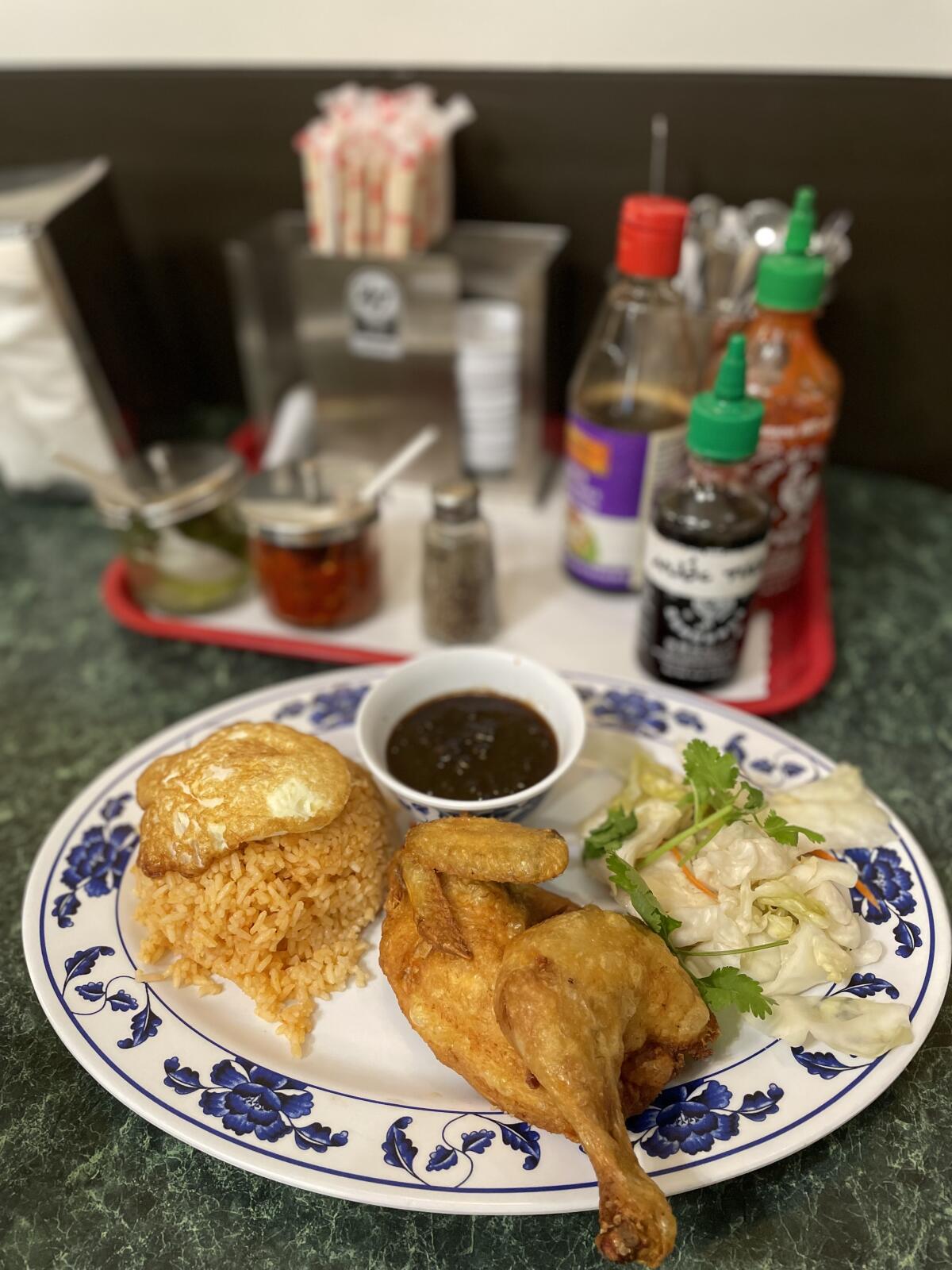
VIETNAM
Nha Hang $1.99 Restaurant, 12035 W. Garden Grove Blvd., Garden Grove
Nha Hang $1.99 Restaurant, 7971 Westminster Blvd., Westminster
Before you get too excited: No, Nha Hang $1.99 Restaurant no longer sells anything for $1.99. Like the 99 Cents Only stores and Dollar Tree, the restaurant’s short-sighted idea for a name stopped making sense 10 years ago, when the last of its dishes went for the price. In these inflationary times, the marquee stands as nothing more than a wistful reminder of how cheap things used to be.
This isn’t to say that the restaurant isn’t trying to keep prices low. As of this writing, nearly all the dishes fall under the $10 mark. The one exception is its signature dish: cơm gà chiên, which translates to “fried chicken with rice.” For now, the dish retails for less than $11, and what you get is a balanced meal with a half chicken, dome of fried rice tinted red with tomato paste, a lacy fried egg, a mess of pickled veggies, and a bowl of savory-sweet sauce that is as beguiling today as when I first had it a decade ago.
This mystery sauce, which involves soy sauce and sugar, has a secret ingredient that makes it slightly chunky but essential to dab on every bite. What are those chunks? Is it fried onion? Some sort of jelly?
Some things, like the Colonel’s secret blend of 11 herbs and spices, are best left unknown.
All the latest on Orange County from Orange County.
Get our free TimesOC newsletter.
You may occasionally receive promotional content from the Daily Pilot.



